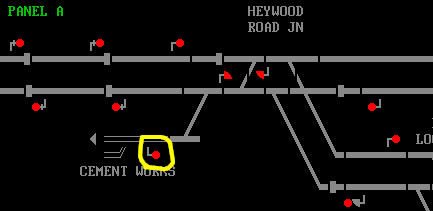Page 1 of 1
| I cant find Westbury Cement Works & signal 394 16/08/2015 at 17:55 #75165 | |
|
leg_iron
44 posts |
I'm playing Westbury 2011 timetable & I have a train from the Cement Works that's held at Signal 39 4but I cant find the signal 394. I've had a look on the signal diagram that's part of the Westbury manual but I cant find this signal. According to the train list, this signal is on Westbury Work station "A". Can anyone help?
Last edited: 16/08/2015 at 17:57 by leg_iron Log in to reply |
| I cant find Westbury Cement Works & signal 394 16/08/2015 at 18:01 #75167 | |
|
Temple Meads
308 posts |
394 is the signal circled in the attached image..
Post has attachments. Log in to view them. Username TIM in multiplayer Log in to reply The following user said thank you: leg_iron |
| I cant find Westbury Cement Works & signal 394 16/08/2015 at 18:12 #75168 | |
|
leg_iron
44 posts |
Was having a senior moment!
Log in to reply The following user said thank you: Temple Meads |
| I cant find Westbury Cement Works & signal 394 17/08/2015 at 00:18 #75178 | |
|
pedroathome
932 posts |
As a quick tip on any Western Region sim, you can generally easily find a signal number without too much effort just knowing this. Numbering runs in a sequence, the down line counts on odd numbers starting from the UP end, and the up in even starting from the Down end. Generally speaking, signals on adjaent lines, such as at Exeter St Davids in the Down direction has E60 as the Down Main signal, but then there is E160, E260 etc on the other lines. In this case, find a signal ending in 60. and you are in the roughly right place. Same applies in your example, but on a lower number of signal example. The Auto signals follow a number pattern of miles from Paddington (or other named location) via a given route, so again will run sequentially. I'm sure though someone will find exceptions to this James P.S. I'm sure that someone will be able to find exceptions to these general sorts of rules, for example one I just thought of is I don't think that Temple Meads station area follows this sort of numbering practice Last edited: 17/08/2015 at 00:19 by pedroathome Log in to reply |
| I cant find Westbury Cement Works & signal 394 17/08/2015 at 07:04 #75179 | |
|
JamesN
1626 posts |
" said:As a quick tip on any Western Region sim, you can generally easily find a signal number without too much effort just knowing this.The original "Western" MAS numbering scheme was actually the other way round - OO2 was the first signal on the down main outside Paddington (the platform starting signals were numbered sequentially from 71 for some odd reason), and B1 being the first signal on the up main approaching Bridgwater. All the "original" WR panels (Old Oak, Slough, Reading, Oxford, Swindon, Bristol, Gloucester, Newport, Cardiff, Port Talbot and Plymouth) followed this pattern. Westbury and Exeter, being later scheme bucked the trend. Signal numbers still increased in the normal direction of travel, but odds and evens reversed. When Slough IECC was introduced a new numbering scheme was formulated, and signal numbers allocated for the whole of western route. This had odds on the down, evens on the up, but signal numbers now decrease towards London. The current Western Route Modernisation is using these allocated numbers (with the odd prefixing of 1000 in the Reading area, which has broken the numbering further down the line) Last edited: 17/08/2015 at 07:06 by JamesN Log in to reply |